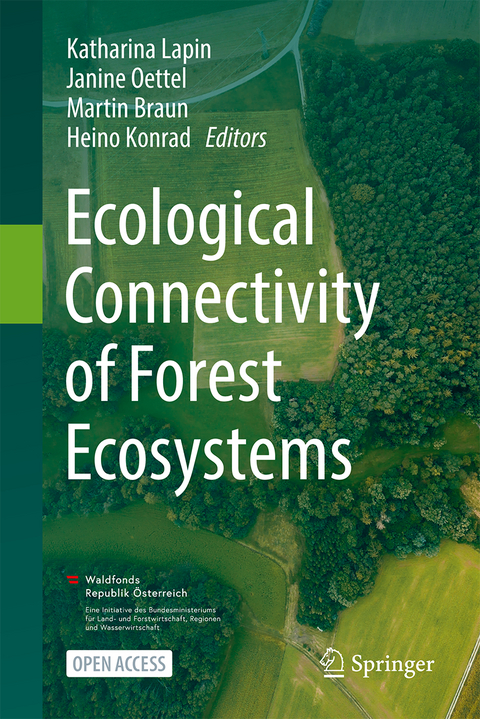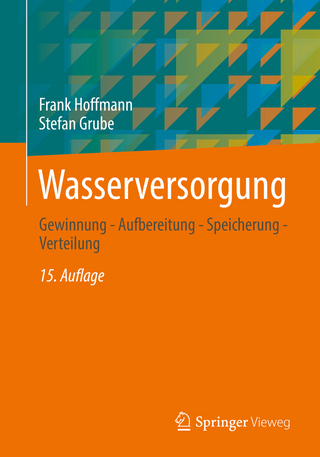
Ecological Connectivity of Forest Ecosystems
Springer International Publishing (Verlag)
978-3-031-82205-6 (ISBN)
- Noch nicht erschienen - erscheint am 29.03.2025
- Versandkostenfrei innerhalb Deutschlands
- Auch auf Rechnung
- Verfügbarkeit in der Filiale vor Ort prüfen
- Artikel merken
This professional volume provides scientific background and practical guidance on forest management in light of ecological connectivity. Readers will gain a great understanding of shifting species in response to climate change and the resulting loss of various resources. The main drivers of these variations are the quality of the availability, quantity, and quality of habitats in the landscape, the genetic diversity of species populations, and the ability to navigate through a fragmented landscape matrix. The connectivity of habitats is gaining importance in the combat of both, the biodiversity crisis and the climate change crisis.
Improving ecological connectivity, however, does not automatically benefit all species, as the examples described in the book demonstrate. Specific planning tools, active monitoring protocols, and management measures are needed to increase the benefit for species with low dispersal and small population size, which generally fail to migrate. Assisted migration can help to prevent species extinction, but also offer opportunities for pathogens to cross geographical barriers.
The vast majority of the known diversity of plants, fungi, vertebrates, and invertebrates depends on forest ecosystems. This volume helps to spread this message and prepare students for their later careers in the forestry sector, while also informing active practitioners and policy makers.
This is an open access book.
Katharina Lapin is the head of the Department for Forest Biodiversity and Nature Conservation at the Austrian Research Centre for Forests (BFW). She holds a PhD in Landscape Planning and Landscape Architecture from the University of Natural Resources and Life Sciences, Vienna. She has made significant contributions to forest biodiversity management, vegetation science, invasion biology, and biodiversity conservation through over 30 publications and participation in more than 20 research projects. Dr. Lapin is dedicated to translating scientific results into practical applications, particularly in conservation and restoration programs. She is actively involved in international collaboration and multidisciplinary networks, including the European Network for Environmental Citizenship, the IUCN SSC Invasive Species Specialist Group, and as the Austrian Focal Point for the Forest Invasive Species Network for Europe and Central Asia (REUFIS). She volunteers as an environmental consultant and educator and regularly engages in lectures and workshops to facilitate knowledge transfer. Her primary scientific motivations include assessing and promoting forest biodiversity, particularly in the context of climate change. Dr. Lapin is passionate about restoration efforts for forest-related biodiversity and ecosystem services and enjoys the challenges of international, multilingual collaboration. Her extensive expertise and experience make her an ideal editor for a book on the Ecological Connectivity of Forest Ecosystems. Her vision for the book focuses on enhancing understanding and communication, fostering transnational cooperation, and facilitating knowledge transfer to increase connectivity, aligning with her broader goals of improving conservation efforts and ensuring the sustainability of forest ecosystems globally.
Janine Oettel is the head of the Forest Biodiversity Unit at the Department of Forest Biodiversity and Nature Conservation at the Austrian Research Centre for Forests (BFW). She holds a PhD in Biology from the University of Vienna and has a strong background in forestry and nature conservation. Her research primarily focuses on forest-dwelling species and their habitats in the context of climate change, including deadwood, tree-related microhabitats, and other forest structures. She emphasizes the critical importance of these structures for biodiversity and conservation. Janine Oettel's expertise includes modeling the abiotic, biotic, and anthropogenic influences on forest-dwelling species and forest structures. Her doctoral thesis on the characteristics and dynamics of deadwood under forest management and climate change earned her the Stefan M. Gergely Award for Outstanding Dissertations in Environmental, Nature and Species Conservation. Since 2021, Dr. Oettel has led the Austrian stepping stone program, dedicated to the nationwide establishment and investigation of stepping stones in forests. This program aims to enhance habitat connectivity and promote biodiversity conservation across the country. Her practical experience and innovative research make her an ideal editor for this book.
Martin Braun is an environmental data analyst at the Austrian Research Centre for Forests (BFW) with substantiated experience in forest sector modelling, natural hazards modelling, forest economics and forest ecology. For eight years Martin Braun worked on analyses relating to market and market dynamics in the forest-based sector. His research focussed on carbon dynamics and the analysis of economic interactions between different sectors of the wood products market. During his work, he made important contributions to the national greenhouse gas inventory and to the development of indicators and stylised facts on the forest-based sector. He has been working as an environmental data analyst at BFW's Institute for Forest Biodiversity and Nature Conservation f
Part 1: Understanding Ecological Connectivity.- Chapter 1: Concepts, Measures, and Models for Assessing Connectivity.- Chapter 2: Species on the Move: Migration, Range Shifts, and Dispersal of Species.- Chapter 3: Do Saproxylic Species Need Habitats, Connectivity, or Connected Habitats?.- Chapter 4: The State of Forest Genetic Diversity: Anthropogenic Impacts and Conservation Initiatives.- Chapter 5: Genetic Connectivity and Local Adaptation of Forest Trees in the Face of Climate Change.- Chapter 6: Forest Ecosystems under Climate Change.- Chapter 7: Soil: The Foundation for Ecological Connectivity of Forest Ecosystems.- Part 2: Monitoring and Assessment Techniques.- Chapter 8: Monitoring Methods for the Protection of Connectivity in Forest Ecosystems.- Chapter 9: Monitoring Habitat Fragmentation and Biodiversity in Forest Ecosystems.- Chapter 10: Habitat Quality and Quantity: Features and Metrics.- Chapter 11: In Situ and Ex Situ Conservation Measures.- Chapter 12: Practical Guidance for Rapid Biodiversity Assessment in Central European Forests.- Part 3: Restoration, Social Dynamics, and Policy Frameworks.- Chapter 13: Restoring Forest Landscape Connectivity- Why, Where and How?.- Chapter 14: Assisted Migration as a Climate Change Adaptation Strategy.- Chapter 15: Forest Genetic Resources under Climate Change: Institutional Framework, Conservation Measures and Biotechnologies.- Chapter 16: Managing Forest Health in Connected Landscapes.- Chapter 17: Managing Invasive Alien Species in Forest Corridors and Stepping Stones.- Chapter 18: Ecological Connectivity in Urban and Semi-urban Forests.- Chapter 19: Connectivity in the Social-Ecological Context and Nature's Contribution to People.- Chapter 20: Conservation Initiatives to Connect the Landscape Across Indigenous and Local Communities.- Chapter 21: Ecological Connectivity Perspectives for Policy and Practice.- Part 4: Case Studies in Ecological Connectivity.- Chapter 22: Austria: The Austrian Stepping Stone Program: A Bottom-Up Approach.- Chapter 23: Argentina: Balancing Connectivity and Production in Forest Reserves.- Chapter 24: Botswana: Stand Structure and Hampered Regeneration of Woody Species in Kazuma Forest Reserve, the Busiest Elephant Corridor in Northern Botswana.- Chapter 25: Brazil: Applied Nucleation through Key Microsites.- Chapter 26: Chile: Increasing Connectivity for Nature and People in Highly Anthropogenic Landscapes.- Chapter 27: China: Ecological Restoration Projects for Connected Landscapes.- Chapter 28: Ethiopia: Enhancing Landscape Connectivity through Agroforests.- Chapter 29: Hungary and Austria: Best Practice for Habitat and Species Connectivity: European Beech and Sessile Oak.- Chapter 30: India: Hotspot of Connectivity Research and Conservation in Central India.- Chapter 31: Republic of Korea: Predicting Shifts in Forest Biodiversity.- Chapter 32: Mongolia: Connectivity Conservation actions in the Khan Khentii region.- Chapter 33: Paraguay: Towards a Landscape Restoration of the Paraguayan Atlantic Forest.- Chapter 34: Serbia: Transnational Ecological Corridor Connectivity and Invasive Plant Species (Sava River Basin).- Chapter 35: Tanzania: The Eastern Arc Mountains Forests as World Natural Heritage: Status and Future Prospects.- Chapter 36: Tunisia: Genetic Diversity Assessment of Cork Oak Provenance Trials in the Context of Climate Change.- Chapter 37: Assisted Regeneration to Restore Lost Forests (Case Study - United Kingdom/Scotland).
| Erscheint lt. Verlag | 29.3.2025 |
|---|---|
| Zusatzinfo | XIX, 614 p. 217 illus., 211 illus. in color. |
| Verlagsort | Cham |
| Sprache | englisch |
| Maße | 155 x 235 mm |
| Themenwelt | Naturwissenschaften ► Biologie ► Ökologie / Naturschutz |
| Weitere Fachgebiete ► Land- / Forstwirtschaft / Fischerei | |
| Schlagworte | Biodiversity Loss • cliamte change adaptation • ecological connectivity • forest ecosystems • forests • genetic diversity • Habitat • Habitat fragmentations habitat degradation • In situ and Ex situ conservation • migration of forest species • nature conservation • open access • restoration • SDG15 |
| ISBN-10 | 3-031-82205-6 / 3031822056 |
| ISBN-13 | 978-3-031-82205-6 / 9783031822056 |
| Zustand | Neuware |
| Informationen gemäß Produktsicherheitsverordnung (GPSR) | |
| Haben Sie eine Frage zum Produkt? |
aus dem Bereich


